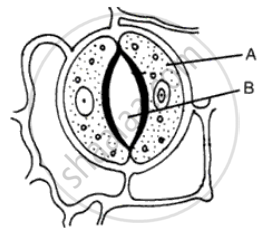Advertisements
Advertisements
प्रश्न
Differentiate Between Transpiration and Translocation.
उत्तर
| Transpiration | Translocation |
| It is the loss of water in the form of water vapour from the aerial organs of the plant. | It is the transfer of prepared food to the different parts of the plant, including the storage organs. |
| It occurs through stomata. | It occurs through vascular tissues. |
APPEARS IN
संबंधित प्रश्न
Which of the following statements are true and which ones are false? Give reason in support of your answer.
Hydathodes are similar to stomata in plant physiology.
Given below is an apparatus which has setup to investigate a physiological process in plants. The setup was placed in bright sunlight. Answer the questions that follow:

Why was the pot enclosed in a rubber sheet?
Answer the following (only in few words);
Where does transpiration take place in leaves? Give names of the various parts.
The diagram alongside represents a structure found in a leaf. Study the same and answer the questions that follow:
(i) Name the parts labeled A and B.
(ii) What is the biological term for the above structure?
(iii) What is the function of the part labeled A?
(iv) Mention two structural features of A, which help in the function mentioned in (iii) above?
(v) Where is this structure likely to be found in a leaf?
(vi) The structure (fig.5.22) helps in the process of transpiration. Explain the term transpiration.
(vii) How many other cells are found surrounding this structure as seen in the diagram?

Differentiate Between Cuticular and Lenticular transpiration.
Name the following:
Holes present on the surface of the stems and twigs for transpiration.
Give Technical Term
The apparatus used to compare the rate of transpiration in cut shoot.
Write the functional activity of the following structure:
Hydathodes
Column ‘II’ is a list of items related to ideas in Column ‘I’. Match the term in Column ‘II’ with a suitable idea given in Column ‘I’.
| Column I | Column II |
| (i) Transpiration | (a) Cacti plants |
| (ii) Movement of water | (b) Stomata |
| (iii) Guttation | (c) Maize plant |
| (iv) Low rate of transpiration | (d)Xylem |
| (v) The high rate of transpiration | (e) Hydathodes |
Transpiration is significant for all except ______.
